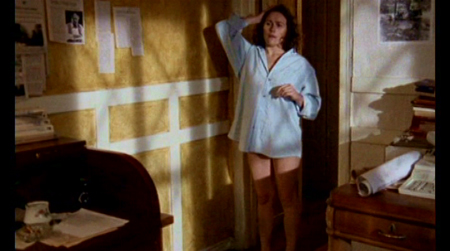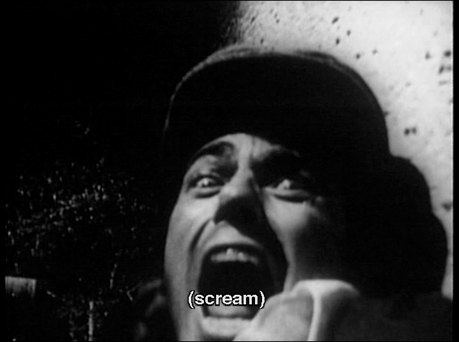BUY IT AT AMAZON: CLICK HERE!
STUDIO: Lurker Films
MSRP: $19.95
RATED: NR
RUNNING TIME: 120 minutes (features total)
SPECIAL FEATURES:
• Bonus short films
• Interview w/ Ramsey Campbell, Robert M. price
• Information booklet
The Pitch
“It’s the
prototype for the narrative tricks of The Twilight Zone, and most of The
Scary Door.”
The Humans
Rodrigo
Sepulveda, Luis Alarcon, Fernando Gallardo, Cristian Campos.
The Nutshell
An
American master of gothic art, Richard Upton Pickman, relocates to
frightening and disturbing work of his career; but a trail of bodies seems to
follow his pursuit of art. An investigative journalist (Sepulveda) begins a
hunt for the reclusive artist. This being a Lovecraft story, you’d be correct
to assume that the poor reporter doesn’t earn a Pulitzer for his efforts,
nationality notwithstanding.

A woman in a Lovecraft story? Gasp!
The Lowdown
The title
of the disc says Pickman’s Model, but the main feature is called Chilean
Gothic. This fourth volume of the HP Lovecraft collection anthologizes
several different versions of the author’s minor but affecting story of art,
obsession, and — surprise! — madness. Chilean Gothic, produced by Gilberto
Villarroel, is a sixty-minute feature, while the other two interpretations are
shorts in the twenty-to-thirty minute range. For the sake of focus, I’ll write
mostly about Chilean Gothic here, and consider the two shorts as bonus
features.
Lovecraft’s
origin Pickman’s Model was narrated by an artsy fellow who had been
acquainted with Richard Upton Pickman, and set in the Northeast of America. Villarroel
has done a clever job of expanding on the narrative, preserving its intent and
even some of the events, while relocating it completely. In Villarroel’s
version, Pickman went expatriate, abandoning
local society, thanks to his reclusive ways and horrifying output, which leads
him deeper and deeper into the underbelly of
dreadful — an unwilling muse — waits.

"Smurf poop" used to be a perfectly reasonable profanity.
There’s a
significant and lasting challenge for filmmakers attempting to adapt
Lovecraft’s work to the screen. The writer’s avowed philosophy of fiction
emphasized “atmosphere over action,” which is much easier to accomplish in written
narrative, where time and sensation can be lengthened. In narrative film,
action is necessary to communicate the story; a cinematic emphasis on
atmosphere will result in a very poor adaptation of the story, since it will
lack the necessary plot.
With Chilean
Gothic, Villaroel has executed an admirable balance between the action
and the atmosphere. He ensured that the audience never sees the monsters — a
lesson that many other horror filmmakers have adopted to varying degrees of
success — but includes enough in the way of action to satisfy the cinematic
need for momentum. What’s more the additions to Lovecraft’s original story are
worthy ones, expanding on certain roles and contracting others to make a cohesive
story rooted in the place of
historical witchcraft has been diminished, but in its place rises a reasonable
replacement in local legend.
I
wouldn’t say that Chilean Gothic is the best Lovecraft adaptation that I’ve ever
seen (I’m pretty fond of the HP Lovecraft Historical Society’s silent Call
of Cthulhu effort), but it is chock full of artistic decisions made
with care and executed with skill. With the action brought to a higher
prominence, it still manages to maintain the all-important atmosphere, which
too-often falls by the wayside in Lovecraft adaptations.

"I’m Edward Carnby. It’s dark. I’m alone."
The Package
A
personal note to Lurker Films: You guys are incredible. This compilation series
of Lovecraft adaptations is a Lovecraft fan’s wet and vulgar dream. In addition
to the little-seen feature, this disc also includes two additional shorts that
take different approaches to the “Pickman’s Model” story. One is a
black-and-white short by Cathy Welch, notable for its melodramatic mode and
stark, Germanic cinematography. The other is an Italian-language flick by
Giovanni Furore, which is shot beautifully and stays pretty close to the source
material. Both add a tremendous wealth to the collector’s experience.
Also on
the disc are two shorter shorts, one computer animated adaptation of the story
“In the Vault” and the other a quick, frightening take on “Between the Stars.”

Damn it, I want Freakazoid DVDs.
Beyond
these cinematic bonuses, there’s also a scholarly interview with historian
Robert M. Price and horror author Ramsey Campbell on the topic of Lovecraft,
his literary aspirations, and his life. It’s a wonderful, erudite segment,
which gives a lot of credit to the genre founding-father. There’s also liner
notes (ah, blessed liner notes!) containing several short essays and
informational pieces from the likes of Lurker Films’ Andrew Migliore, filmmaker
Cathy Welch, and Ramsey Campbell.
This
disc, as a representative of Lurker Films’ mission to compile the best of
Lovecraft-on-screen, simply kicks ass.
9 out of 10
